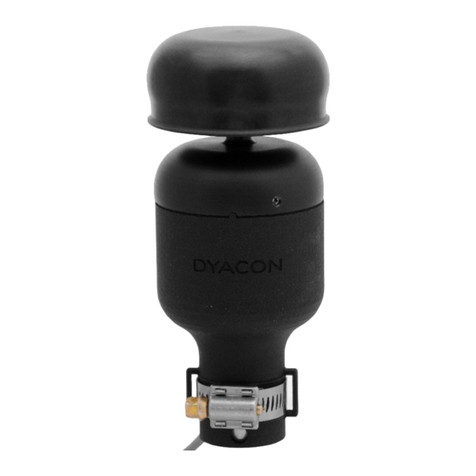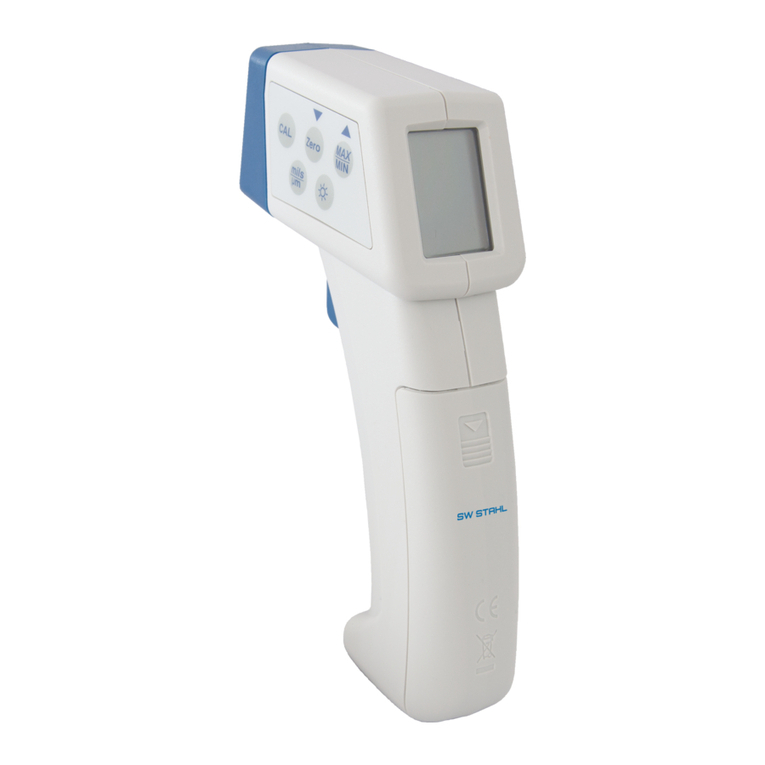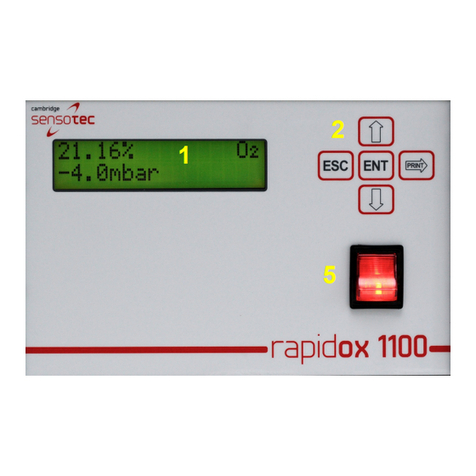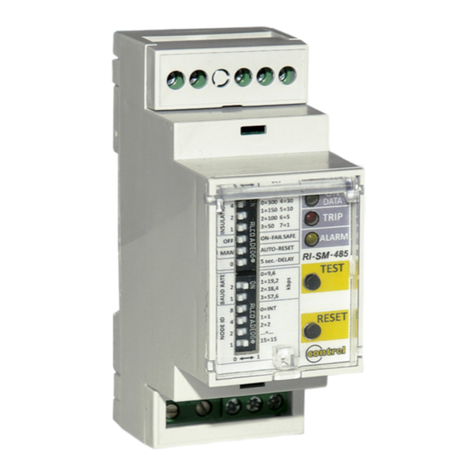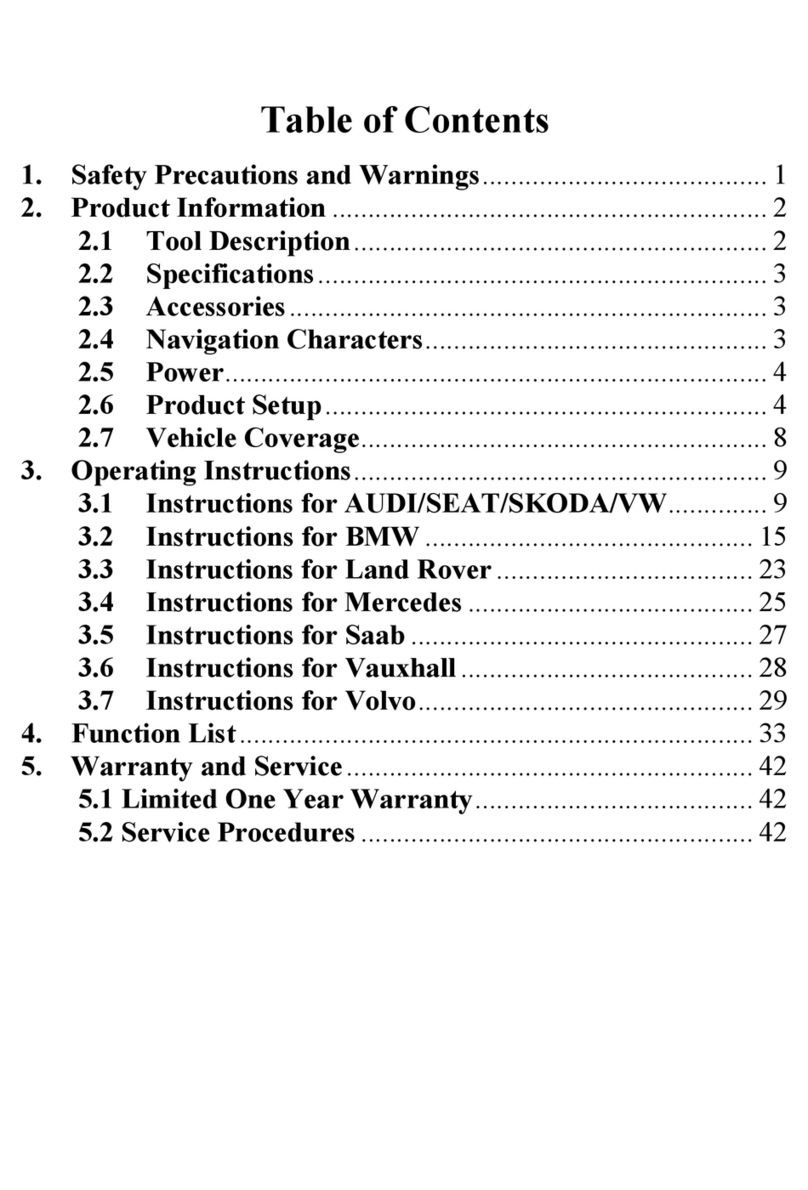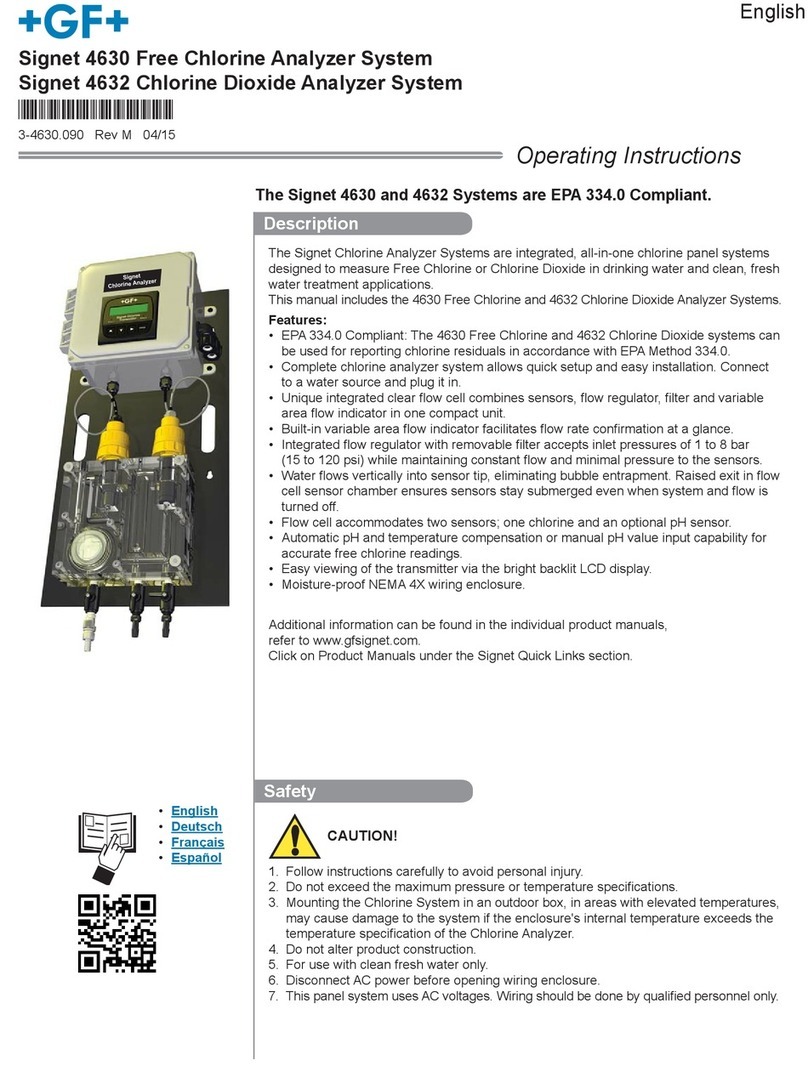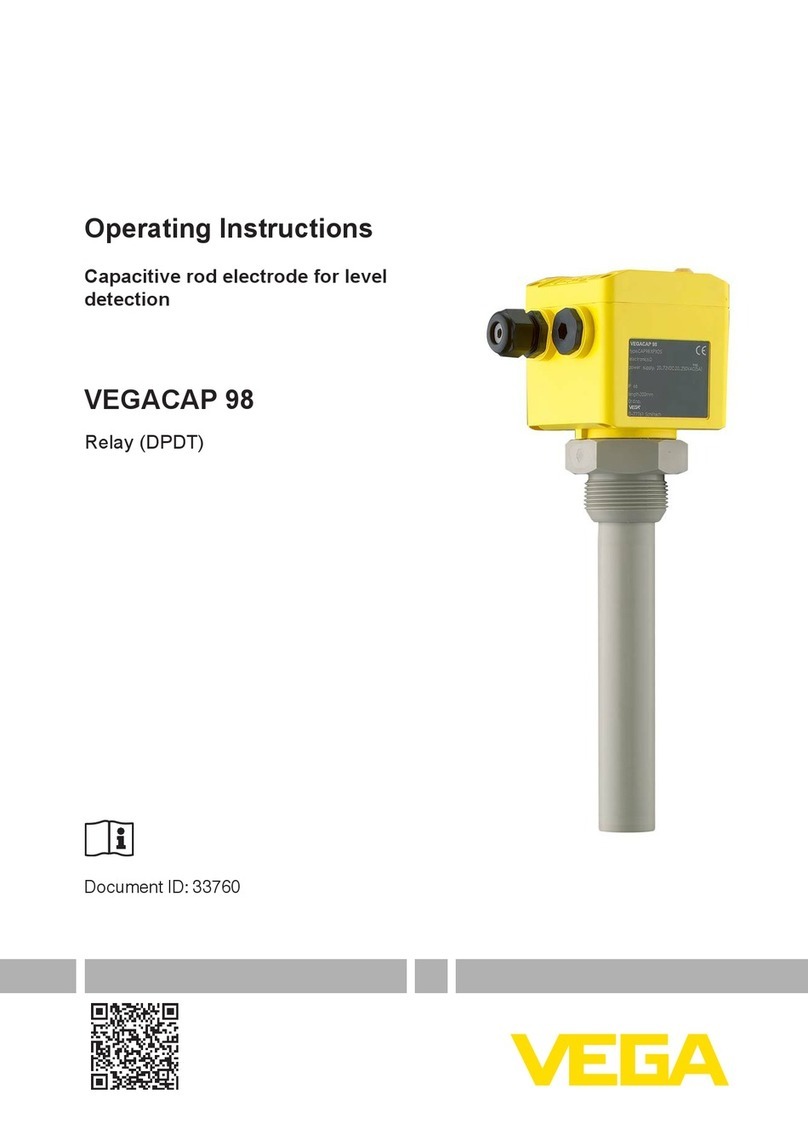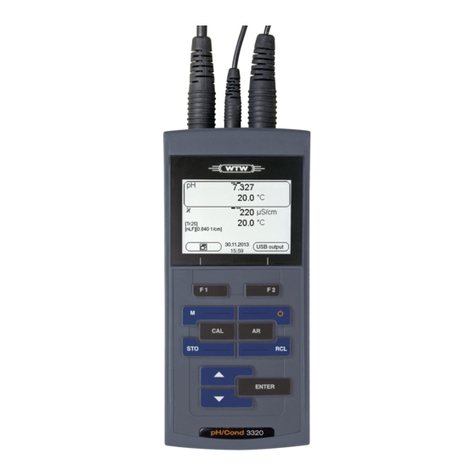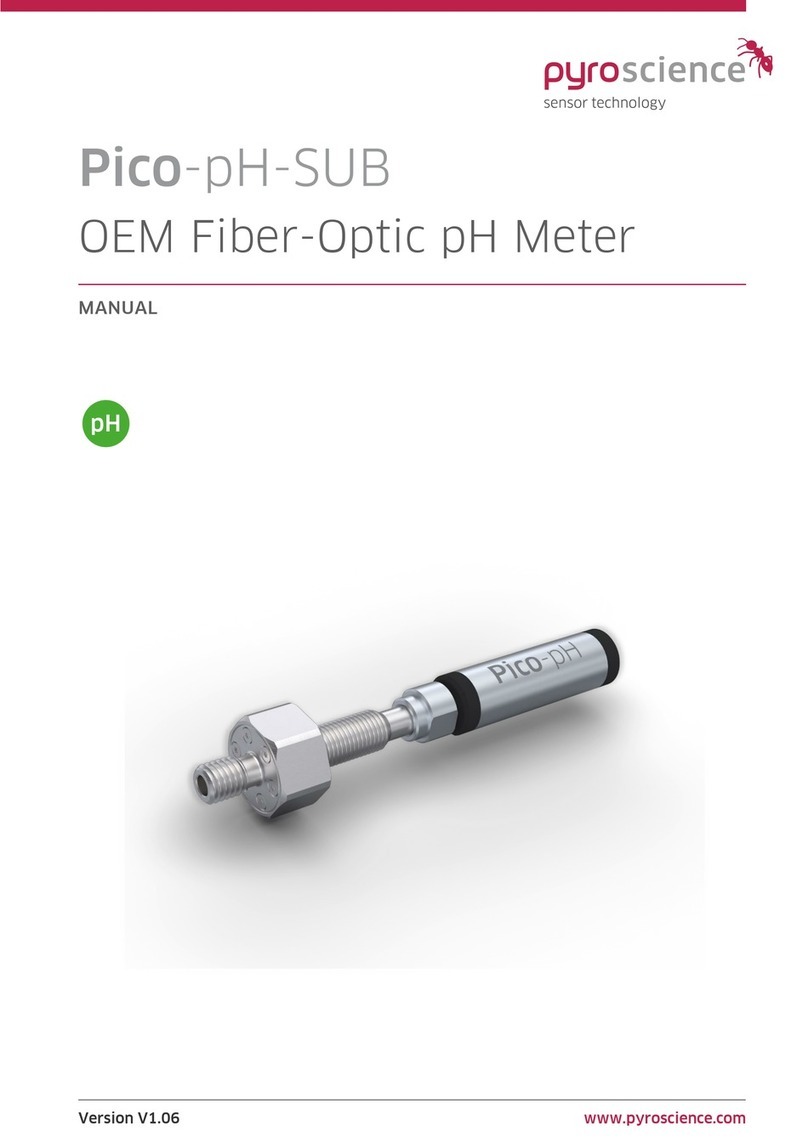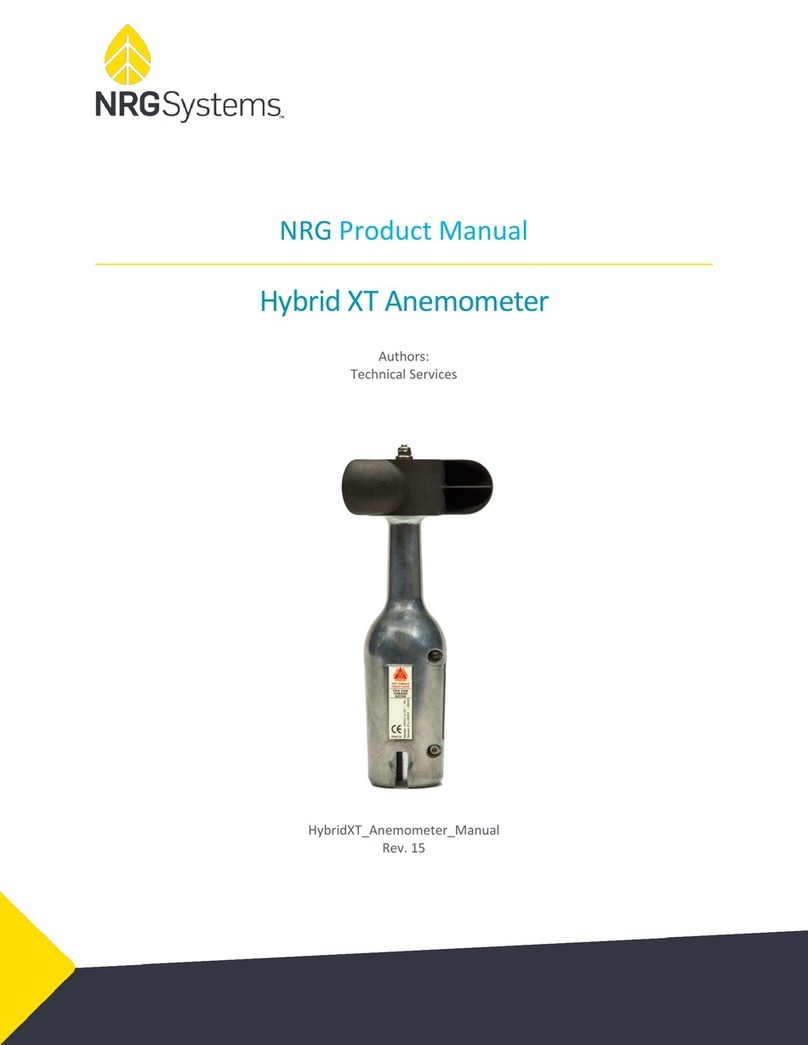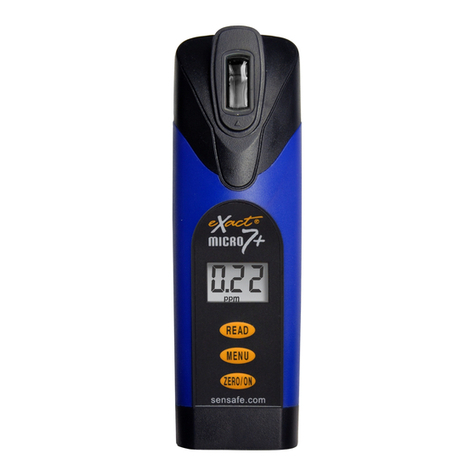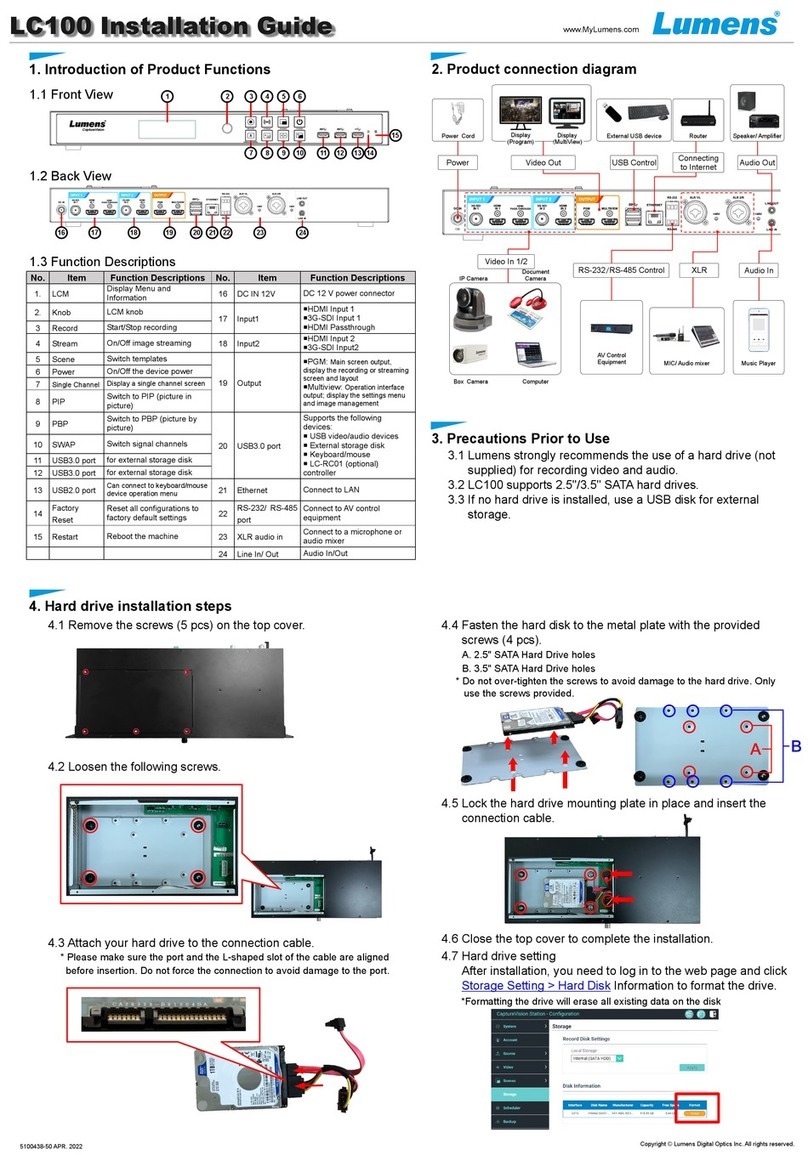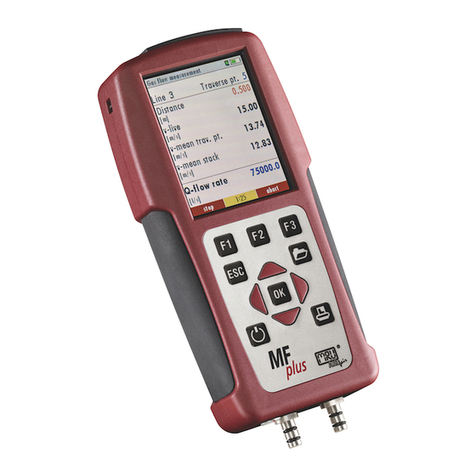Felix Instruments F-751 User manual

F-751 Avocado Operation Manual Rev. 1/25/2023
Felix Instruments
1554 NE 3rd Ave
Camas, WA 98607, USA
Phone: +1 (360) 833-8835
Fax: +1 (360) 833-1914
www.felixinstruments.com
Avocado Quality Meter
F-751
Operations Manual

F-751 Avocado Operation Manual Rev. 1/25/2023
Back To Table of Contents
Page |2
Felix Instruments
1554 NE 3rd Ave
Camas, WA 98607, USA
Phone: +1 (360) 833-8835
Fax: +1 (360) 833-1914
www.felixinstruments.com
DECLARATION OF CONFORMITY
Manufacturer:
CID Bio Science, Inc.
Felix Instruments –Applied Food Science
1554 NE 3rd Ave
Camas, WA 98607
Declares that the CE-marked Product:
Product Model(s):
Model F-75x
FCC Compliance Statement:
This device complies with part 15 of the FCC Rules. Operation is
subject to the following two conditions: (1) This device may not cause
harmful interference, and (2) this device must accept any interference
received, including interference that may cause undesired operation.
Complies With:
89/336/EEC Electromagnetic Compatibility Directive
73/23/EEC Low Voltage Directive
Compliance Standards:
EN 55027 RF Emissions Information Technology Equipment
EN 50082-1 EMC Immunity Standard
EN 60950 Safety of Information Technology Equipment
Including Electrical Business Equipment
December 31, 2018 ______________________________
Leonard Felix
President

F-751 Avocado Operation Manual Rev. 1/25/2023
Felix Instruments
1554 NE 3rd Ave
Camas, WA 98607, USA
Phone: +1 (360) 833-8835
Fax: +1 (360) 833-1914
www.felixinstruments.com
Contents
Introduction .................................... 4
Theory of Operation ................ 5
Measurement Variance ........... 6
Natural Variation of DM in
Avocados............................. 6
Variance Due to Analytical
Procedure............................ 7
Measurement Variance Due
to Instrument ...................... 7
Device Overview & Setup............... 8
Package Contents .................... 8
Loading the Battery ................. 8
Protecting Your Device ............ 8
Device Interface....................... 9
Navigating Menus ............... 9
Entering Text/Numbers....... 9
Device in Use ................................ 10
Powering On the Device ........ 10
Device Options Menu ............ 10
Connecting to a Wireless
Network ............................ 10
GPS Settings ...................... 10
GPS Settings (Cont.) .......... 11
Data Server........................ 11
Uploading To FruitMaps.... 11
Bin Setup .................................... 12
Fruit Per Bin................................ 12
Bin Options ............................ 13
Bin Prefix ........................... 13
Tags ................................... 13
Fruit Per Bin....................... 13
Enforce Bin Size................. 13
Sides Per Fruit ................... 14
Scans Per Side ................... 14
Maturity Criteria................ 14
Measurement Offsets ....... 14
Archive Data .......................... 15
Measurements Preparation... 15
Measuring Avocados ............. 16
Taking Measurements..................17
Bin Summary.......................... 18
Measurement Evaluation .............19
Accessing Measurements on a
PC: Using the SD Card ............ 19
Accessing Measurements on a
PC: Using the Data Server...... 21
Accessing Measurements on
FruitMaps............................... 23
Updating The F-751 .....................24
Updating Device Firmware .... 24
Updating App......................... 25
Troubleshooting ...........................26
Contact Felix Instruments:..... 26
Contents

F-751 Avocado Operation Manual Rev. 1/25/2023
Felix Instruments
1554 NE 3rd Ave
Camas, WA 98607, USA
Phone: +1 (360) 833-8835
Fax: +1 (360) 833-1914
www.felixinstruments.com
Introduction
Felix Instruments’ F-751 Avocado Quality Meter is a fast, portable tool for non-
destructively measuring avocado fruit quality. The F-751 can provide rapid dry
matter estimations for large numbers of fruit, giving orchard-wide estimations
and insights previously unattainable through traditional testing methods.
The F-751 primarily measures dry matter (DM). Dry matter is the inverse of
moisture content and can be thought of as the part of an avocado which would
remain if all the water content were removed. Due to its direct correlation to
mesocarp oil content, dry matter is the most common quality and maturity
index used to assess avocados. Maturity at harvest is directly correlated to
ripening time and fruit quality.
The F-751 uses light interactance in the NIR wavelength range to determine the
DM content of a conical region of mesocarp in the location where the lens is
placed on the fruit. Since the F-751 can be thought of as a “spot measurement”,
we recommend scanning at both the dorsal and ventral sides of the equator of
the avocado and using the average to gain the most accurate insight into the
average dry matter of the whole fruit.

F-751 Avocado Operation Manual Rev. 1/25/2023
Back To Table of Contents
Page |5
Felix Instruments
1554 NE 3rd Ave
Camas, WA 98607, USA
Phone: +1 (360) 833-8835
Fax: +1 (360) 833-1914
www.felixinstruments.com
Incident
Beam
Backscattered light
Illuminated
Region
Figure 2. Schematic of light scattering
within an object after being struck with
Vis-NIR radiation from a spectrometer.
Incident light is reflected, absorbed, or
transmitted depending on the physical
and chemical composition of the sample
(Diagram adapted from Lu et al., 2017).
The F-751 Quality Meter utilizes a light interactance geometry (Fig. 1 & 2), in
which a halogen lamp directs NIR and visible light into the commodity. As light
Theory of Operation
At Felix Instruments, visible and near-infrared (Vis-NIR) spectroscopy
instrumentation is utilized to collect spectral signature data of various
agricultural and food commodities. This spectral data is then used alongside
data from destructive analytical testing to create predictive models that can
rapidly and non-destructively evaluate external and internal quality traits of
the commodity.
penetrates a sample, photons scatter,
and the resulting reflectance,
transmittance, and interactance spectra
is collected by a fiber optic lens (Lu et al.,
2017 & Cavaco et al., 2020). The resulting
frequency and wavelengths are called a
spectrum, enabling users to identify and
quantify the chemical composition of a
sample. To create regression-based
predictive models from this spectral data,
artificial neural networks (ANN) are
employed during chemometric analysis.
The use of ANN enables users to extract
hidden or unknown relationships in
complex multivariate datasets (Héberger,
2008). Some of the quality traits in
agricultural and food commodities that
are commonly modeled using NIR
spectroscopy and chemometrics include:
dry matter content (DM), total soluble
solids (TSS), titratable acidity (TA), pH, fat
content, water content, phenols, etc.
Figure 1. Geometrical configuration
of Vis-NIR spectra that may be
acquired in spectroscopic analysis.
Light is split when it strikes an object,
as some photons are absorbed, and
others are reflected (A) reflectance,
(B) transmittance, and (C)
interactance modes (Diagram
adapted from Cavaco et al.)
A
B
C

F-751 Avocado Operation Manual Rev. 1/25/2023
Back To Table of Contents
Page |6
Felix Instruments
1554 NE 3rd Ave
Camas, WA 98607, USA
Phone: +1 (360) 833-8835
Fax: +1 (360) 833-1914
www.felixinstruments.com
Figure 3. Dry matter variation. Image adapted from Phetsomphou, 2000.
Measurement Variance
Factors that affect measurement variance include:
1. Natural variation of dry matter throughout the fruit
2. Analytical procedure
3. Accuracy of the instrument
Natural Variation of DM in Avocados
Dry matter is not homogeneously distributed throughout the mesocarp
(flesh) of the avocado (See Figure 3). It is possible to see a variation up to
15% DM or more depending on where the mesocarp is sampled. Therefore,
it is critical for the user to take multiple measurements at various locations
on a single avocado to obtain the most accurate prediction for the average
DM of that single avocado.
Outer: 33.6%
Middle: 39.1%
Inner: 38.0%
Outer: 36.0%
Middle: 36.4%
Inner: 26.9%
Outer: 29.4%
Middle: 39.8%
Inner: 45.2%

F-751 Avocado Operation Manual Rev. 1/25/2023
Back To Table of Contents
Page |7
Felix Instruments
1554 NE 3rd Ave
Camas, WA 98607, USA
Phone: +1 (360) 833-8835
Fax: +1 (360) 833-1914
www.felixinstruments.com
Variance Due to Analytical Procedure
Every measurement method has inherent sources of error. For most
gravimetric methods (e.g., oven, microwave, etc.) error can be attributed to
unrepresentative sampling and measurement error associated with
equipment (e.g., the balance not being properly calibrated, temperature not
being monitored, etc.). The F-751 most similarly mimics the coring sampling
technique, and thus will provide the most comparable results when the user
destructively analyzes a core sample taken from the scan site.
If a sampling technique other than coring is being utilized, then extra
precautions (e.g., increasing the number of scans and scan sites on the
avocado) must be taken to ensure the average DM value given by the
instrument aligns with current destructive testing methods.
Measurement Variance Due to Instrument
The new avocado application has been created with artificial neural
network (ANN) chemometrics, which has drastically reduced the amount of
inter-instrument variation. This ensures a high level of repeatability and
accuracy when taking measurements with the F-751. However, if the user
wishes to further reduce their measurement variation, it is recommended
that they increase their sample size. Increasing the sample size decreases
error significantly. Using the average DM of ten fruit will typically deliver
30% better performance than using the average DM of five fruit. Because it
is quick to measure with the F-751, we recommend a larger sample size that
delivers the desired performance.

F-751 Avocado Operation Manual Rev. 1/25/2023
Back To Table of Contents
Page |8
Felix Instruments
1554 NE 3rd Ave
Camas, WA 98607, USA
Phone: +1 (360) 833-8835
Fax: +1 (360) 833-1914
www.felixinstruments.com
Figure 4. F-751 Parts
Device Overview & Setup
Package Contents
The instrument will arrive in a carrying case that includes:
Loading the Battery
The F-751 uses two 18650 Li-ion 3.7 V 3500 mAh rechargeable batteries.
The batteries must be removed from the F-751 to be charged. To remove
the batteries, twist the battery compartment cap counterclockwise, which is
located on the bottom of the device under the rubber bumper (See figure 7
on page 9). The cap can be tightened or loosened by twisting with fingers or
a screwdriver. Use caution when removing the batteries, as the cap is spring
loaded. Both batteries should be inserted into the unit positive (+) side first
(facing towards the lens).
Additional protected 18650 batteries can be purchased from a preferred
battery vendor.
Warning: Do not drop batteries, this may cause them to crack and rupture.
Protecting Your Device
Ensure that the rubber bumpers on the top and bottom of the F-751 are
always installed when using the instrument, as they protect it from water
damage.
The hand strap should be tightened so that the device has a snug and secure
fit around the hand. If the lens becomes dirty, it can be cleaned with a soft
cloth. The lens is made of extremely durable Gorilla Glass and should not
become scratched with normal use
Part
Quantity
F-751 Avocado Quality Meter
1
Removable Rechargeable batteries
4
Battery Charger
1
Hand Strap
1
Coring Tool
1
Lens Cloth
1
USB A to USB Micro Cable
1

F-751 Avocado Operation Manual Rev. 1/25/2023
Back To Table of Contents
Page |9
Felix Instruments
1554 NE 3rd Ave
Camas, WA 98607, USA
Phone: +1 (360) 833-8835
Fax: +1 (360) 833-1914
www.felixinstruments.com
Device Interface
Observe the location of the key features on the F-751:
Navigating Menus
The instrument’s interface is composed
of menus that are operated using
navigation buttons.
Up/Down navigates between menu
items.
Left navigates back to the previous
menu.
Right navigates into the selected menu
item.
Entering Text/Numbers
When prompted, text/numbers can be
entered on the device by using the
navigation buttons.
Up/Down navigates between
letters/numbers for the current cursor
position.
Left navigates the cursor to text that
has already been entered. Navigating
past the beginning of the text aborts
and returns to the previous menu.
Right navigates the cursor to text that
has already been entered. Navigating
past the end of the text saves the
desired entry and continues.
Figure 7. Bottom of Device
Figure 6. Top of Device
Figure 5. Front of Device
SD Card Slot
Measurement Lens
Battery Housing
Tripod Adaptor
Power On/Off Button
Measure Button
Navigation Buttons
Micro USB Port

F-751 Avocado Operation Manual Rev. 1/25/2023
Back To Table of Contents
Page |10
Felix Instruments
1554 NE 3rd Ave
Camas, WA 98607, USA
Phone: +1 (360) 833-8835
Fax: +1 (360) 833-1914
www.felixinstruments.com
Device in Use
Powering On the Device
Press the Power On/Off button to
power on the instrument.
This process takes a few moments,
and the display will show the splash
screen when the instrument is
prepared to measure avocados.
Device Options Menu
Upon turning on the device, press
Right to navigate to the main menu.
Highlight Device Options and press
Right to access the device’s options
menu. From this menu, basic device
settings including Date and Time,
Keypad and Notification Sounds,
Backlight Intensity, and Language
Settings, can be adjusted.
Connecting to a Wireless Network
The F-751’s possess Wi-Fi capabilities, allowing for a streamlined data
uploading process. Highlight Wi-Fi and press Right. Highlight Wi-Fi State and
press Right. Use the Up/Down buttons to select between enabling or
disabling this feature and press Right to confirm selection.
Highlight Networks, then press Right. Select a network, enter the passcode
as directed on-screen, and press Right to confirm selection.
GPS Settings
The F-751’s GPS feature allows users to get accurate GPS data for each
measurement taken. Highlight GPS and press Right. Highlight GPS State and
press Right. Use the Up/Down buttons to select between enabling or
disabling this feature and press Right to confirm selection. This process takes
a few moments.
Once GPS State is enabled, users can view latitude, longitude, accuracy status,
and more. To view this, highlight View Status and press Right.
Wi-Fi
Date and Time
Sounds (Enabled)
Backlight (Disabled)
Language
Data Server
FruitMaps.com
GPS
Avo
Press to record a measurement
Press to view the main menu
S/N: 751-002-00000
V0.0.0 build 00000
100%
App Build: 00/00/0000 00:00
Figure 8. F-751 Startup Screen
Figure 9. Device Options Menu

F-751 Avocado Operation Manual Rev. 1/25/2023
Back To Table of Contents
Page |11
Felix Instruments
1554 NE 3rd Ave
Camas, WA 98607, USA
Phone: +1 (360) 833-8835
Fax: +1 (360) 833-1914
www.felixinstruments.com
GPS Settings (Cont.)
Highlight Upload Date\Time using GPS and press Right. Use the Up/Down
buttons to select between enabling or disabling this feature and press Right
to confirm selection. Enter the desired Time zone Offset and press Right.
The instrument should now display date\time based on the entered time
zone offset.
Data Server
Enable automatic upload to a
Data Sever upon archiving
measurements. Highlight Data
Server and press Right.
Highlight Upload on Archive
and press Right. Use the
Up/Down buttons to select
between enabling or disabling
this feature and press Right to
confirm selection.
Highlight Sever Address and press Right. The default address within this
menu is the Felix Instruments FTP Server. Input the address of the desired
data server and press Right to confirm the selection.
See page 21 for further instruction on uploading F-751 measurements to a
Data Server.
Uploading To FruitMaps
FruitMaps is a program available for free to all F-751 users, that transposes
data generated on the instrument into a visual format, allowing for users to
plot their crops, generate harvest prediction dates, and more (See page 23
for more information).
Highlight FruitMaps.com and press Right. Highlight Upload on Archive and
press Right. Use the Up/Down buttons to select between enabling or
disabling this feature and press Right to confirm selection.
See page 23 for further instruction on uploading F-751 measurements to
FruitMaps.
Upload on Archive (Enabled)
Server Address
Figure 10. Archive Settings

F-751 Avocado Operation Manual Rev. 1/25/2023
Back To Table of Contents
Page |12
Felix Instruments
1554 NE 3rd Ave
Camas, WA 98607, USA
Phone: +1 (360) 833-8835
Fax: +1 (360) 833-1914
www.felixinstruments.com
Bin Setup
Bins are the vehicles for storing
measurements taken on the
instrument. Setup a new bin by
navigating to App Menu > Select Bin
> Create New Bin. Highlight Create
New Bin and press Right to create an
empty bin.
After selecting Create New Bin, a
prompt will appear to enter the ID
number for the bin. This number can be any number from 1-999. Press
Right after entering the value.
If you have previously created one or
more bins and have not archived the
data on the device, this menu will
display a list of those bins underneath
the Create New Bin option. To view,
edit, add (or remove) measurements
from a previously created bin, simply
highlight the bin you wish to access
and press Right.
Fruit Per Bin
A prompt will appear to enter the
number of fruit to be measured within
the bin. This number can be any
number from 1-999. Press Right after
entering the value. A new bin will be
created, and the user can begin taking
measurements (See page 17).
Select Bin
Options
Archive Data
Figure 11. Avo App Menu
Enter the ID number for this bin.
Scroll up and down to select characters.
Scroll right past the value entered to continue.
Scroll left past the value entered to abort.
0
Figure 12. New Bin Creation Prompt:
Setting a bin ID #
Enter the number of fruit for this bin.
Scroll up and down to select characters.
Scroll right past the value entered to continue.
Scroll left past the value entered to abort.
5
Figure 13. New Bin Creation
Prompt: Setting Fruit Per Bin

F-751 Avocado Operation Manual Rev. 1/25/2023
Back To Table of Contents
Page |13
Felix Instruments
1554 NE 3rd Ave
Camas, WA 98607, USA
Phone: +1 (360) 833-8835
Fax: +1 (360) 833-1914
www.felixinstruments.com
Bin Options
Users can adjust bin settings
prior to taking measurements.
From the App Menu, highlight
Options and press Right to
access bin customization
options.
Bin Prefix
Users can change the prefix
“Bin” to any desired prefix (i.e., Lot, MA, Region, etc.). Highlight Bin Prefix
and press Right. Enter the desired prefix for new bins and press Right to
confirm selection. This new bin prefix will not alter bins created prior to
adjusting the prefix.
Tags
Tags help users to differentiate between factors influencing measurement
results through metadata. Highlight Tags and press Right. Enter the desired
metadata tag for new measurements and press Right to confirm selection.
This new tag will not alter measurements created prior to adjusting the tag.
Fruit Per Bin
Users can set a default number of fruit per bin. All new bins created will
automatically be set to the fruit per bin chosen by the user.
Highlight Fruit Per Bin and press Right. Enter the desired number of fruit
per bin and press Right to confirm selection. By selecting Always use this
bin size, all new bins created will automatically be set to the bin size chosen
by the user. Allow changes for new bins will allow the user to adjust bin size
whenever a new bin is created.
Enforce Bin Size
Enabling this feature will prevent users from scanning more fruit than the
set fruit per bin number. By disabling this feature, users can scan as many
fruit as desired, despite a set bin size. This feature is disabled by default.
Highlight Enforce Bin Size and press Right. Use the Up/Down buttons to
select between enabling or disabling this feature and press Right to confirm
selection.
Bin Prefix
Tags
Fruit Per Bin
Enforce Bin Size Scans Per Side
Scans Per Side
Enforce Bin Size
Maturity Criteria
Figure 14. Bin Options Menu
Measurement Offsets

F-751 Avocado Operation Manual Rev. 1/25/2023
Back To Table of Contents
Page |14
Felix Instruments
1554 NE 3rd Ave
Camas, WA 98607, USA
Phone: +1 (360) 833-8835
Fax: +1 (360) 833-1914
www.felixinstruments.com
Sides Per Fruit
Users can set a default number of sides per fruit. All new bins created will
automatically be set to the sides per fruit chosen by the user.
Highlight Sides Per Fruit and press Right. Enter the desired number of sides
per fruit and press Right to confirm selection.
Scans Per Side
Users can set a default number of scans per side. All new bins created will
automatically be set to the scans per side chosen by the user.
Highlight Scans Per Side and press Right. Enter the desired number of scans
per side and press Right to confirm selection.
Maturity Criteria
The Maturity Criteria Threshold can be used to track the percentage of fruit
that exceeds a specified DM threshold. This statistic is reported in the Bin
Summary menu. The Maturity Criteria threshold value and the offset values
can be accessed and edited through this menu.
Highlight Maturity Criteria and press Right. Enter the desired number and
press Right to confirm selection.
Measurement Offsets
The Measurement Offset is determined through a calibration process,
which is performed prior to the instrument being shipped. However, in
some cases the user may need to perform an offset calibration to achieve
accurate measurements. If you notice that your instrument is predicting
consistently higher or lower than it should be, please contact Felix
Instruments Support to receive instructions on how to perform an offset
calibration.
Highlight Measurement Offset > DM and press Right. Enter the desired
number and press Right to confirm selection.

F-751 Avocado Operation Manual Rev. 1/25/2023
Back To Table of Contents
Page |15
Felix Instruments
1554 NE 3rd Ave
Camas, WA 98607, USA
Phone: +1 (360) 833-8835
Fax: +1 (360) 833-1914
www.felixinstruments.com
Archive Data
Archiving data allows users
to keep measurements easily
organized and prevent
clutter. The user can also
choose to allow the archived
data to automatically be sent
directly to FruitMaps.com or
a Data Server (See page 11)
in addition to the archived
folder on the SD card.
From the main menu, navigate to App Menu > Archive Data, and press
Right. Once prompted with the Archive Measurements screen, press Right
to complete the archiving process. The instrument data can now be
accessed through the archive folder on the SD Card (See page 19).
Measurements Preparation
To begin taking
measurements, navigate
from the App Menu > Select
Bin and press Right. Select
between Create New Bin or
a pre-existing Bin.
After completing the
procedure on page 12, the
main measurement screen
will be displayed. When no
measurements have been
taken, the screen will
display “Empty.” Press
Up/Down to view or edit
each individual fruit
measurement.
Archive Measurements
Data will be moved to the archive folder
on the SD Card.
Press Right to continue
Press Left to abort
Figure 15. Archive Measurements Screen
Create New Bin
Figure 16. New Bin Creation Screen
BIN001 Fruit 1 –Side A (1 of 2)
Fruit 0 of 10
Empty
Side A
Empty
Empty
Side B
Figure 17. Measurement Screen

F-751 Avocado Operation Manual Rev. 1/25/2023
Back To Table of Contents
Page |16
Felix Instruments
1554 NE 3rd Ave
Camas, WA 98607, USA
Phone: +1 (360) 833-8835
Fax: +1 (360) 833-1914
www.felixinstruments.com
Measuring Avocados
To ensure the highest degree of accuracy for a single fruit, it is
recommended to perform a minimum of three scans on both the dorsal and
ventral sides of the equator. This is the default configuration for the device.
For small fruit (US Size 60-96), the seed can cause interference due to a
thinner mesocarp layer at the equator. The most common symptom of seed
interference is artificially inflated dry matter results.
The instrument may produce unusually high predictions for a particular
fruit. If this is the case, those results should be discarded, and a
different fruit should be selected for measurement.
Irregularities on the surface of the avocado such as scabs can also
increase measurement error. Users should avoid these areas when
scanning the fruit.
Avocado firmness also plays a critical role in achieving accurate
predictions from the device. Only firm fruit should be measured, as soft
fruit will cause artificially inflated results due to changes in cellular
structure and density.
Figure 18. Where to Scan an Avocado
Ventral
Equator
Scan
Here
Dorsal
Equator
Stem

F-751 Avocado Operation Manual Rev. 1/25/2023
Back To Table of Contents
Page |17
Felix Instruments
1554 NE 3rd Ave
Camas, WA 98607, USA
Phone: +1 (360) 833-8835
Fax: +1 (360) 833-1914
www.felixinstruments.com
Taking Measurements
BIN001 Fruit 1
Fruit 1 of 10
32.8
Side A
31.5 DM
34.0 DM
Side B
32.8
DM
DM
Figure 19. Measurement Screen w/ Scans
Position an avocado horizontally
over the lens of the instrument,
with the dorsal/ventral side of the
equator of the fruit centered over
the lens. Then press the Measure
button to take a measurement. If a
bin has not yet been created, the
device will automatically create an
Ad Hoc bin with the prefix “AH001”.
By default, the device will
automatically perform three
successive scans for each side.
This process takes a few
moments. The display will
show Wait while measuring
the fruit.
Average Dry Matter value
for the currently
selected/measured fruit.
Name and number of the
currently selected/
measured fruit.
Once the measurement has
completed, the device will
make an audible beep and
the screen will display the
measurement results.
Name and number of the current bin.
Average Dry Matter value for the current bin.
a. Number of fruit with completed
measurements out of the total number of
fruit in bin.
b. Bin progress bar (will gradually fill as more
fruit have completed measurements).

F-751 Avocado Operation Manual Rev. 1/25/2023
Back To Table of Contents
Page |18
Felix Instruments
1554 NE 3rd Ave
Camas, WA 98607, USA
Phone: +1 (360) 833-8835
Fax: +1 (360) 833-1914
www.felixinstruments.com
Bin Summary
A bin’s summary statistics can be
viewed at any time by pressing Left
from the Measurement menu. This
screen displays the average, standard
deviation, minimum, and maximum of
the bin’s DM measurements.The
statistic at the bottom of the screen
indicates the percentage of fruit that
have a dry matter value above the
“maturity criteria” threshold that is set
by the user in the Options menu.
Pressing Right from the Measurement
menu will open the Edit Measurement
menu. In this menu, users can delete
all measurements for one side of the
fruit, delete all measurements for the
entire fruit, or delete all
measurements for the current bin.
**WARNING** Once a fruit or a bin is deleted, the data is permanently
removed from the device and cannot be recovered.
BIN001
Fruit 1 of 10 complete
Avg SD Min Max
DM 32.8 1.42 31.4 34.0
100% of fruit > 21.0 DM
Figure 20. Measurement Summary Stats Screen
Delete Side A
Delete Side B
Delete Fruit
Delete Bin
Figure 21. Measurement Options Menu

F-751 Avocado Operation Manual Rev. 1/25/2023
Back To Table of Contents
Page |19
Felix Instruments
1554 NE 3rd Ave
Camas, WA 98607, USA
Phone: +1 (360) 833-8835
Fax: +1 (360) 833-1914
www.felixinstruments.com
Measurement Evaluation
Users have three methods to view and assess measurements.
1. Directly on the instrument interface
2. Offline on your PC using the SD Card or data server
3. Online with FruitMaps.com
Accessing Measurements on a PC: Using the SD Card
1. Turn off the
device.
2. Remove the SD
Card from the
device.
3. Insert the SD Card
into your PC.
4. When measurements are
taken with the instrument, a
comma separated variable .txt
file is created in the root
folder of the SD card that logs
information for each scan.
5. Measurements can be viewed
and edited by right clicking the
.txt file and choosing Open
With > Microsoft Excel.
6. When opening the .txt file
type, Microsoft Excel will
automatically guide the user
through a series of prompts.
Simply click Next > through
the wizard and then Finish.
This will ensure data is
delimited into columns within
Microsoft Excel.
Figure 22. SD Card Folder on PC
Figure 23. Exporting Measurements to Excel

F-751 Avocado Operation Manual Rev. 1/25/2023
Back To Table of Contents
Page |20
Felix Instruments
1554 NE 3rd Ave
Camas, WA 98607, USA
Phone: +1 (360) 833-8835
Fax: +1 (360) 833-1914
www.felixinstruments.com
7. The .txt log file contains the following identifying information for each
measurement:
8. Data that has been archived on the instrument will appear in a unique
folder found within the Archive folder. Data that has not been archived can
be accessed in the Data folder. Applications containing the chemometric
models are housed within the Apps folder.
Timestamp
Measurement ID
Device ID (Serial #)
Bin
Fruit
Side
Scan
Tags
Latitude
Longitude
DM
Figure 24. Measurement .txt Log
Figure 25. F-751 SD card Archive Folder on PC
Other manuals for F-751
1
Table of contents
Other Felix Instruments Measuring Instrument manuals
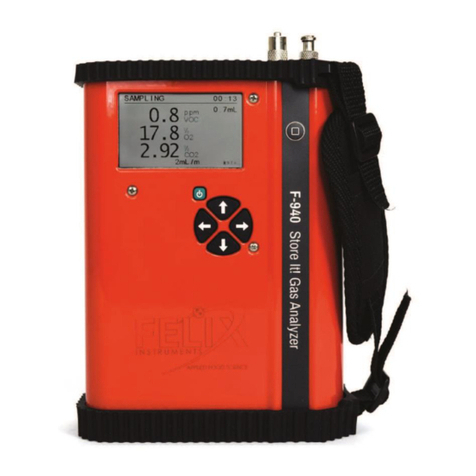
Felix Instruments
Felix Instruments F-940 User manual
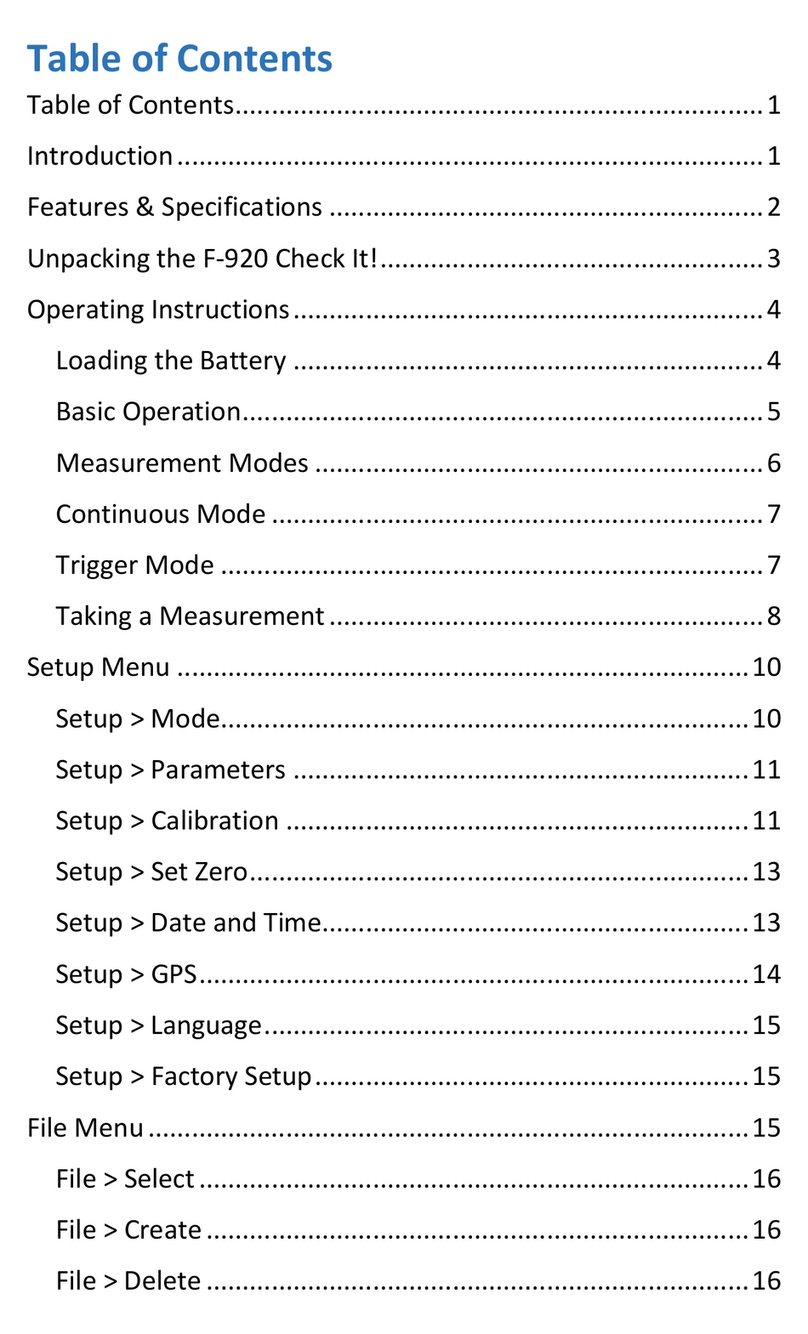
Felix Instruments
Felix Instruments F-920 User manual
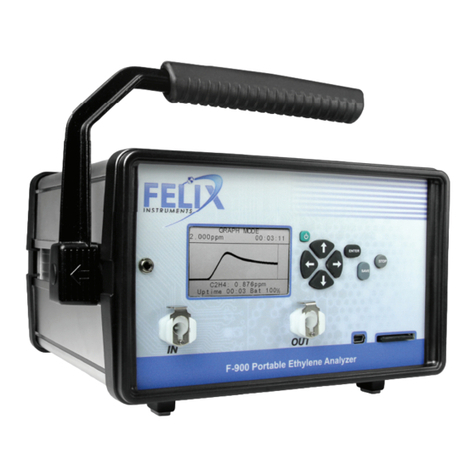
Felix Instruments
Felix Instruments F-900 User manual

Felix Instruments
Felix Instruments F-900 User manual
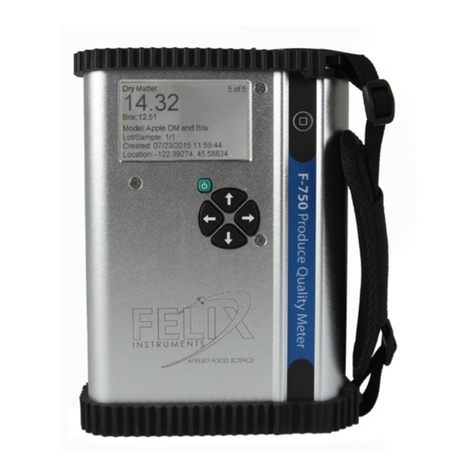
Felix Instruments
Felix Instruments F-750 User manual
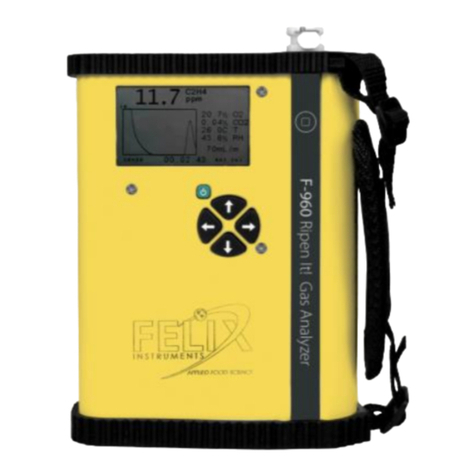
Felix Instruments
Felix Instruments F-960 User manual

Felix Instruments
Felix Instruments F-900 User manual
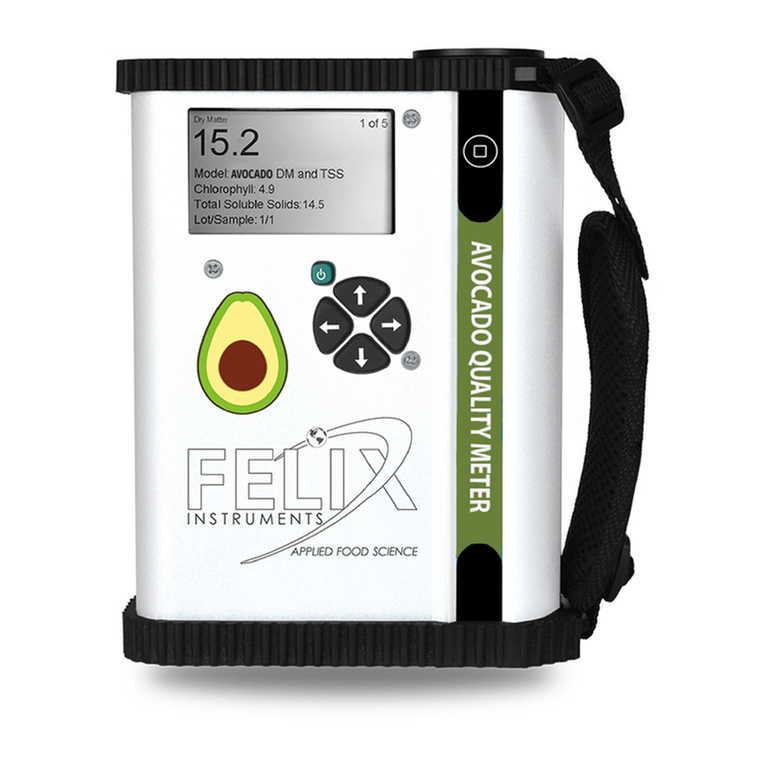
Felix Instruments
Felix Instruments F-751 User manual
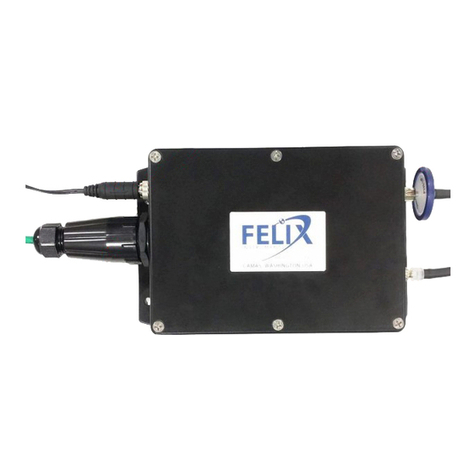
Felix Instruments
Felix Instruments F-901B User manual
